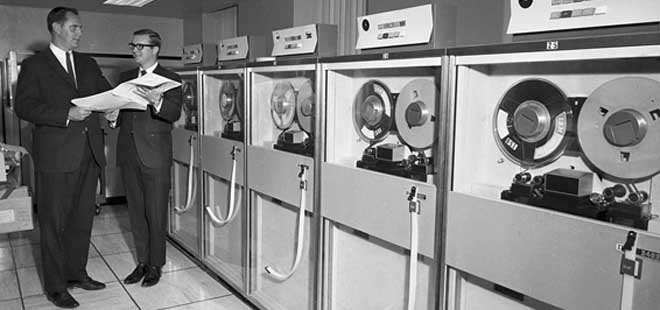A Brief History of Data Storage
It’s mind-blowing to think of how far IT technology has come since the PC first began to be marketed to a mass audience. It’s hard to fathom looking back just how we were able to get along without this technology that has now becomes so ingratiated into all aspects of our everyday lives. Yet the rise of computer technology certainly didn’t happen by accident; as is the case with all solution systems, this technology arose out of a demand to perform tasks more efficiently. To that end, the earliest products performed brilliantly, storing vast amounts of data and making it available for near-immediate retrieval.
Yet as is the case with most new technologies, once computer technology and its accompanying data storage potential was introduced, developers quickly went to work to improve it. Today’s users may think it laughable to contemplate a time when room-sized computers held only bytes of memory, particularly since in today’s world, discussions involving data storage are reaching both the terabyte and petabyte levels. Yet despite an emphasis on advancement, the earliest years of IT proliferation saw relatively slow steps taken to improve the efficiency of data storage devices. For almost 20 years, hard drive technology created by IBM has the workhorse of the data storage industry, and made possible the explosion in popularity of the PC. These earliest drives allowed for storage of up to 60 megabytes on a dual-disk hard drive.
The Advent of Portable Storage Technology
Yet this technology was not without its limitations. Enter Syed Iftikar and his accompanying contribution to the pantheon on data storage devices: the SyQuest drive. What set this technology apart from the others of its day was that it was the first to introduce the concept of removable storage. This offered a number of advantages over fixed drives, chief among them being the ability to expand storage capacity. The first SyQuest drive debuted in 1982 with a 6.38 megabyte storage capacity. By 1987, that capacity was up to 44.5 megabytes on a single removable cartridge drive.
RELATED: What is Database Hosting?
While initially introduced to only the IBM-compatible market, SyQuest actually has Apple to thank for the skyrocketing in popularity that it experienced in the late 80’s. The desktop publishing revolution that began with Apple’s Macintosh line created new demands for greater data storage capacity to support the heavy use of graphics that users now demanded. The typical 80 megabyte capacities of the fixed drives of the day simply couldn’t keep up, and SyQuest drives soon became the data storage solution of choice in the industry.
1995: A Groundbreaking Year
Yet 1995 saw a new dawn in the IT market, when “multimedia” became all the craze in computer technology. Iomega was able to wrestle control of the data storage market away from SyQuest with a product that would revolutionize the storage solution world: the Zip drive. The Zip drive capitalized on the current desire that users had to have a single, easy-to-use storage device on which they could store their personal and business files, as well as their graphics, music, and videos. Originally offered with 100 megabyte storage capacities, the Zip disks would eventually grow to accommodate as many as 750.
Yet while the Zip drive took the portable data storage market by storm, its capacity paled in comparison to the digital video disk, which also first gained a foothold in the market in 1995. Rewritable DVD technologies such as DVD-RAM offered excellent data integrity and storage capacities that where among the first to get up into the gigabyte range. Even today, DVD-RAM technology continues to be utilized in many computers and personal video recorders such as camcorders.
RELATED: Website Copyright Violations: How Will Web Hosts Respond?
Today’s Data Storage Technologies
Yet in terms of user-friendliness and insane amounts of data storage, few previous technologies could compete with what Trek Technology would unleash upon the world in the year 2000. Compatible with the USB ports on all computers and only about the size of the typical human thumb, flash drives (or USB or thumb drives, as they’re also known) soon became the standard for data storage devices. Due to the ease of portability that they allow for and innovative design options available to manufacturers, flash drives remain a popular choice with users today. Current products can hold up to 16 gigabytes. Yet many of the same features that make flash drives so appealing can also present challenges to users. Because they’re so small, they’re easily lost or misplaced. Transit agencies and laundry companies report finding hundreds of thousands of flash drives left on trains and in cabs or in pants pockets every year.
The evolution of data storage took a new turn in 2006 when Amazon Web Services began offering a collection of remote computing services that quickly became known as the cloud computing platform. Rather than using a local server to process, manage, and store data, cloud computing uses a network of remote servers hosted on the Internet. After Amazon launched AWS, other software companies soon followed with cloud platforms of their own, such as Microsoft Azure and Google Drive. Today, it’s estimated that the Cloud currently holds more than 1 Exabyte of data.
RELATED: The ‘End’ of the Internet? What Two-Tiered Service Actually Entails
The Evolving Costs of Data Storage
In the case of most technological revolutions, new technologies command top dollar when first introduced, yet tend to regress to lower prices over times as that technology becomes more readily available to a much broader customer base. The same concept has held true for data storage technologies. In the early days of the industry’s evolution, storing large amounts of data came with a hefty price tag, as it’s estimated that average storage cost per gigabyte was as high as $437,500 in 1980. Yet according to the research site Statistic Brain, this is how those costs have trended since:
- 1985: $105,000/Gig
- 1990: $11,200/Gig
- 1995: $1,120/Gig
- 2000: $11/Gig
- 2005: $1.24/Gig
- 2010: $0.09/Gig
- 2014: $0.03/Gig
Looking back throughout the history of data storage devices gives us the perfect example of technology at work, with needs being identified and products being developed to fill those needs. Yet as technological history has shown us, innovators are constantly looking to build a better mousetrap. Not only is this evident from looking at the progression of data storage devices and their capabilities over the last 20 years, but it makes one wonder of what the future of data storage will be. Developers have already taken basketball-sized disks and drives and been able to drastically reduce them in size while also dramatically increasing their storage capacity. As we move forward, the question on everyone’s mind undoubtedly will be how much more efficient data storage technology can get.




